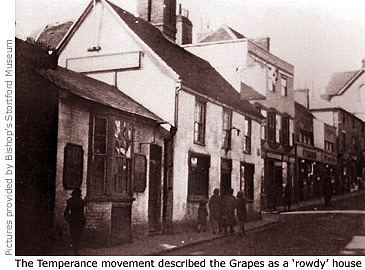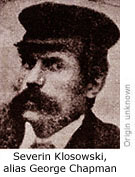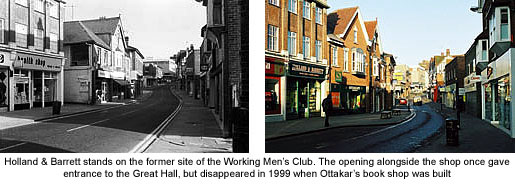|
This shop stands on the former site of the Working Men’s Club, the narrow thoroughfare alongside it that once gave entrance to the Great Hall, now replaced by Waterstones (formerly Ottakar’s) bookshop.
Since 1870 the name Holland & Barrett was more familiar to North Street, a business formed by the partnership of Alfred Slapps Barrett and Major William Holland. There, they bought a grocery store formerly owned by Dodd & Burls, but not wanting to restrict themselves to selling just groceries they also sold mens and womens clothing from the same store. An advertisement from 1874 describes Holland & Barrett as a ‘clothier and grocer’. It was a strange mix!
But the partnership proved extremely successful and by the early 1900s they owned two premises in North Street – the grocery store at the corner of Barrett Lane and a clothing store a few doors along near to the corner of Bridge Street (See Guide 6). The grocery business was then sold in the 1920s to Messrs Alfred Button & Sons. They kept the familiar and popular name of Holland & Barrett, but around 1970 it was sold to Bookers. The same company later bought out another town shop named Heath & Heather (founded by Samuel Ryder of golfing Ryder trophy fame), and similar stores nationwide.
For a short while Holland & Barrett’s North Street shop traded as Budgens grocery store, but eventually many such premises under the Budgens umbrella were renamed Holland & Barrett and marketed as health food shops. Now a household name, the chain of shops (currently around 420) has belonged to American supplement manufacturer NBTY, Inc. since 1997.
|
|
 The building at the south-west corner of Apton Road is of prefabricated construction and houses three shops – No’s 2, 2a & 2c. It would best be described as an architectural aberration. On this same site, some 350 years ago, stood a house of slightly more substance and character that was part of the estate of Doctor Peter Mark Sparke, one time physician to Charles I. He is buried in St Michael's church. The building at the south-west corner of Apton Road is of prefabricated construction and houses three shops – No’s 2, 2a & 2c. It would best be described as an architectural aberration. On this same site, some 350 years ago, stood a house of slightly more substance and character that was part of the estate of Doctor Peter Mark Sparke, one time physician to Charles I. He is buried in St Michael's church.
Around 1850 it was licensed as a public house called the Cherry Tree, taking its name from the pub of that name that had previously stood in the Causeway (See Guide 8). A man by the name of John Usher later owned it, and Apton Road was once called Usher’s Lane.
The pub was then renamed the Grapes and in 1898 licensed to Severin Klosowski, alias George Chapman. Ten years earlier he'd been questioned in connection with Jack the Ripper’s reign of terror in London’s East End, and though any connection with the grizzly murders was later dismissed, a dark side of his character soon emerged.
|
|
 Born in Poland in 1865, Klosowski came to London in 1888. The following year he married another Pole, Lucy Baderski, but in 1890 lived with a woman named Annie Chapman and adopted her surname. In 1895, now calling himself George Chapman, he claimed to be married to Isabella Spink, but when she died he married Bessie Taylor and moved to Bishop’s Stortford as landlord of the Grapes. Born in Poland in 1865, Klosowski came to London in 1888. The following year he married another Pole, Lucy Baderski, but in 1890 lived with a woman named Annie Chapman and adopted her surname. In 1895, now calling himself George Chapman, he claimed to be married to Isabella Spink, but when she died he married Bessie Taylor and moved to Bishop’s Stortford as landlord of the Grapes.
His tenure lasted just eighteen months, the couple moving back to London where Bessie died in 1901. That same year he set up home with his barmaid, Maud Marsh, but when she died shortly after, her mother’s suspicion at her daughter’s early death was endorsed by the family doctor. A post mortem confirmed she had been poisoned. Chapman was arrested and at his trial it was proved all three of his wives, Spink, Taylor and Marsh had been poisoned. He was hanged for their murder in 1902.
The original Grapes public house stood much closer to the road than the present building, but the pub that replaced it – built by Ind Coope in 1934 and also named the Grapes – was set much further back with a pull-in for cars and delivery vehicles. When that pub finally closed for business on Saturday 26 March 1966, the site was bought by Pearl Assurance Company for £85,000. They demolished it the following April or May then redeveloped the site to give us the monstrosity that stands today.
On the opposite side of the road is The Dells, the former site of Firmins rope and sack factory in the 1920s. MORE PICTURES
|





 The building at the south-west corner of Apton Road is of prefabricated construction and houses three shops – No’s 2, 2a & 2c. It would best be described as an architectural aberration. On this same site, some 350 years ago, stood a house of slightly more substance and character that was part of the estate of Doctor Peter Mark Sparke, one time physician to Charles I. He is buried in St Michael's church.
The building at the south-west corner of Apton Road is of prefabricated construction and houses three shops – No’s 2, 2a & 2c. It would best be described as an architectural aberration. On this same site, some 350 years ago, stood a house of slightly more substance and character that was part of the estate of Doctor Peter Mark Sparke, one time physician to Charles I. He is buried in St Michael's church. Born in Poland in 1865, Klosowski came to London in 1888. The following year he married another Pole, Lucy Baderski, but in 1890 lived with a woman named Annie Chapman and adopted her surname. In 1895, now calling himself George Chapman, he claimed to be married to Isabella Spink, but when she died he married Bessie Taylor and moved to Bishop’s Stortford as landlord of the Grapes.
Born in Poland in 1865, Klosowski came to London in 1888. The following year he married another Pole, Lucy Baderski, but in 1890 lived with a woman named Annie Chapman and adopted her surname. In 1895, now calling himself George Chapman, he claimed to be married to Isabella Spink, but when she died he married Bessie Taylor and moved to Bishop’s Stortford as landlord of the Grapes.